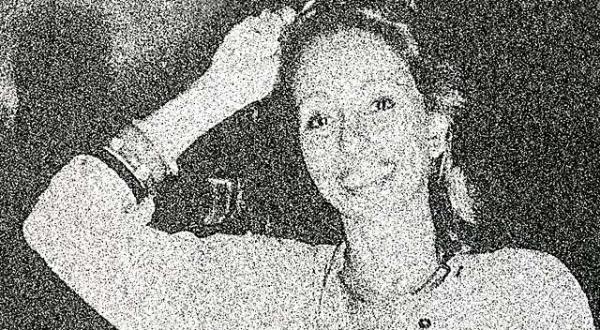
Recognition
1989 AIGA Medal
Born
1938, Brazil
Deceased
1982, Brazil
By Philip B. Meggs
September 1, 1989
Recognized for her profound contribution to American magazine and book design
A vivacious young woman from Rio de Janeiro moves to New York to study design and is later appointed co-art director of the world-renowned Harper's Bazaar magazine at age 25. After 10 years at Bazaar, she becomes the first art director of Ms., the magazine of the women's liberation movement. Other accomplishments include designing award-winning books, working for Rolling Stone, and being chosen to art direct the revival of the 1930s classic, Vanity Fair. She is at the zenith of her career and celebrated for her work when cancer takes her life at age 44.
This chronicle is not fiction. It is the story of Bea Feitler, described by friends and admirers as a “risk-taker,” a “whirlwind persona,” and “an unstoppable creative force.”
Feitler's parents provided a European education offering broad learning and stressing excellence. She showed talent and enthusiasm for art in her teens. Her parents encouraged Feitler's interest, made a global search for the right art school, and chose Parsons School of Design, in Manhattan. Her uncle, Edward Newman, lived in the New York area and provided her with a transitional home.
Feitler was exotic and full of nervous energy. She thrived on the life of the city and her design-school experiences. Music, literature, and the ballet fascinated her. She would wait in line for hours to get standing room at the Met. Her initial interest in illustration yielded to a growing fascination with design. The fashion magazines, especially Harper's Bazaar—art directed by the legendary Alexey Brodovitch until his retirement in 1958, the year before her graduation from Parson's—held a special fascination for her. After graduation she made the rounds in New York, including a visit to Bazaar, where she was told to come back after she had more experience. She decided to return to Brazil and launch her career there. In partnership with two other graphic designers, she started Estudio G specializing in poster, record album, and book design. She also collaborated on the design of the Brazilian magazine Senhor, which was revolutionary among Brazilian cultural and political magazines in its commitment to graphic concepts and progressive design. Senhor provided a wonderful opportunity for Feitler to experiment, to innovate, to succeed, and to fail.
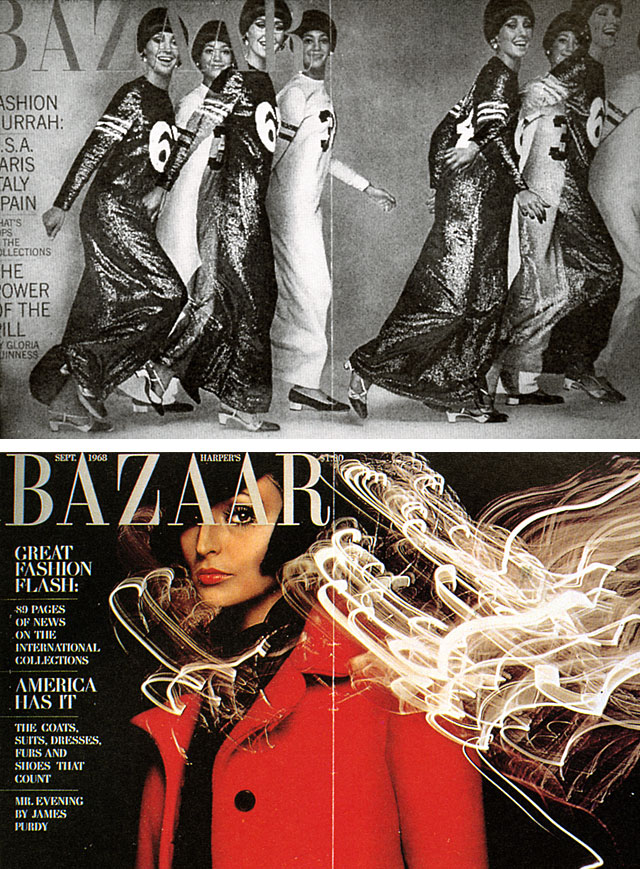
(top) Cover of Bazaar, September 1967. Art Directors: Ruth Ansel, Bea Feitler. Designer: Bea Feitler; Photograph by Hiro. Copyright © 1967. The Hearst Corporation. Courtesy of Harper's Bazaar. (bottom) Cover of Bazaar, April 1969. Art Directors: Ruth Ansel, Bea Feitler; Designer: Bea Feitler; Photograph by Hiro. Copyright © 1969. The Hearst Corporation. Courtesy of Harper's Bazaar.
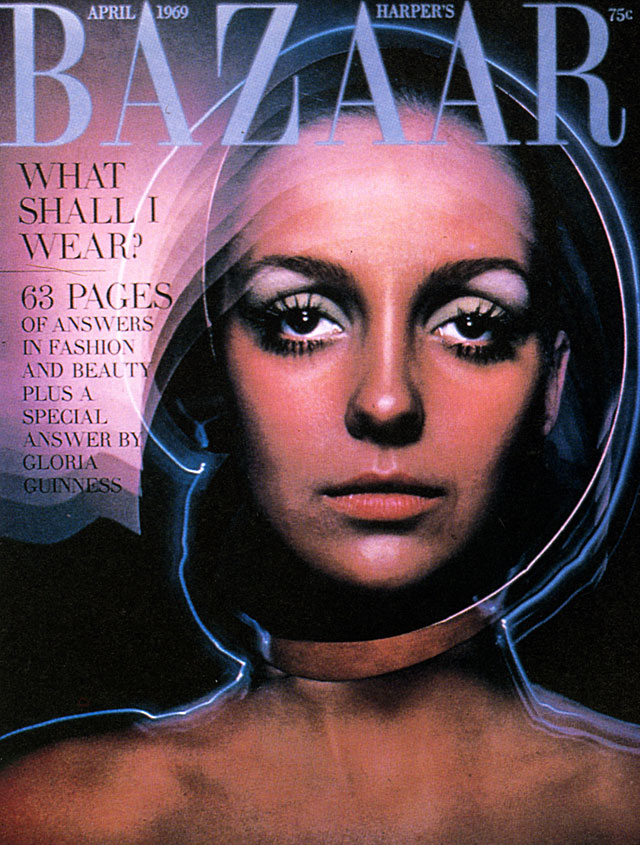
Cover of Bazaar, April 1969. Art Directors: Ruth Ansel, Bea Feitler; Designer: Bea Feitler; Photograph by Hiro. Copyright © 1969. The Hearst Corporation. Courtesy of Harper's Bazaar.
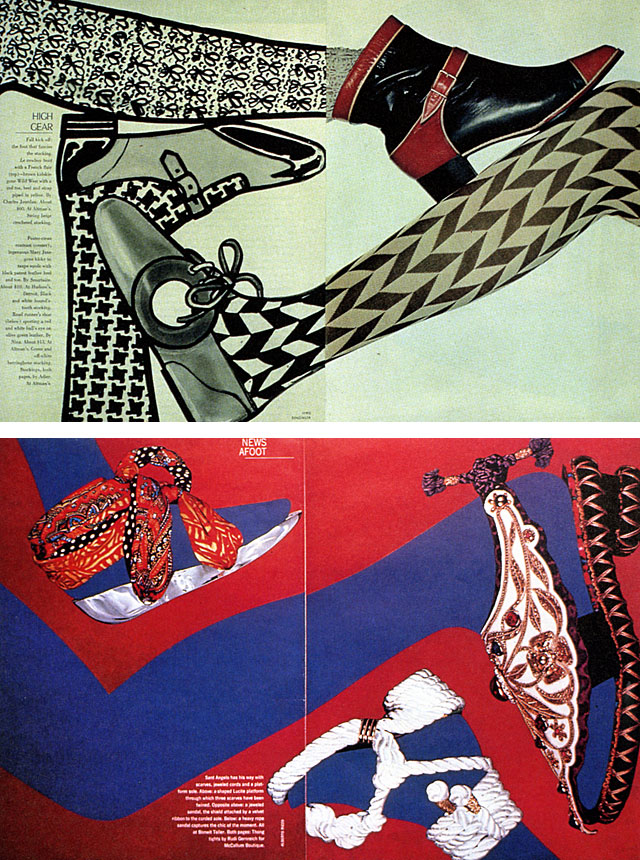
Photograph of Fred Ota, Tom Miller, John Weber, 1953. Thomas H. E. Miller Design Papers, Special Collections and Archives, University of Illinois at Chicago.
Henry Wolf followed Brodovitch as art director of Bazaar in 1958. When Wolf left to become art director of Show in 1961, Marvin Israel, one of Feitler's teachers from Parsons became art director of Bazaar. Two issues later the names Beatriz Feitler and Ruth Ansel appeared on Bazaar's masthead as art assistants. Israel had contacted Feitler in Rio de Janeiro and invited her to return to Manhattan and join him at Bazaar. It was a fabulous opportunity for the 23-year-old designer.
From their first meeting in the offices of Bazaar, Feitler and Ansel felt the mandate of Brodovitch's legacy and hoped to meet him. Though the opportunity never came, they absorbed his influence form Marvin Israel until he left Bazaar in 1963. In a move that received national press comment and surprised the media world, Bazaar promoted Feitler and Ansel, then in their mid-twenties, from art assistants to co art-directors. Pundits in the press who expressed open skepticism about their ability to manage the graphic destiny of one of the world's most sophisticated publications soon ate crow for the synergy and energy of Feitler and Ansel occurred at a time when high fashion was colliding with pop fashion from the streets, rock music and experimental film were extending sensory experience, women and minorities were taking to the streets, and the new art movements, notably Pop and Op, were changing the face of aesthetic experience. Moon rockets, assassinations and the Vietnam War stunned the national psyche. Feitler and Ansel remained true to the best Brodovitch tradition of designing magazines as a harmonious and cinematic whole, while responding to events in the streets of the time, in a collaboration that was organic and mutually supportive. They were open to accidents, material around the studio and events surrounding them. In their office an inspirational wall collage would grow and change, providing an unending source for invention. Feitler once summed up her editorial design philosophy: “A magazine should flow. It should have rhythm. You can't look at one page alone, you have to visualize what comes before and after. Good editorial design is all about creating a harmonic flow.”
Friends remember Feitler's energy as inexhaustible, and her zest for life as exuberant and extravagant. A stunning contradiction was at the center of her being. She was a traditionalist with a deep devotion to her family and a sense of her cultural history. Yet she was filled with the spirit of the sixties. Close associates recall that she handled the dichotomy well. Her present was undaunted by any struggle between her past and her future.
In a 1968 Graphics article, photographer Richard Avedon recalled working with Feitler and Ansel on the April 1965 Bazaar cover. The deadline was past, it was after 11 p.m., and the photographs of Jean Shrimpton in a “space helmet” designed by one of New York's most famous milliners did not work.
“Ruth started to explain that we could cut the shape of the space helmet out of Day-Glo paper,” Avedon wrote, “but she never finished because Bea was already cutting the shape. Rubber cement, color swatches. An eighth of an inch between the pink helmet and the grey background. No, a sixteenth. I was in the room and I don't know how it happened. And it all happened in minutes—the moment was absolute magic, to watch Bea, the classicist, and Ruth, the modern, work as if they were one person.”
The final cover with Avedon's photograph of Jean Shrimpton—now peering from behind a bright pink Day-Glo space helmet with the logo vibrating against it in acid green—won the New York Art Director's Club medal and has been often reproduced as an emblem of the sixties.
Bazaar of the 1960s was a dynamic statement of its time. Rollicking sequence photography, cinematic pacing, incredible scale changes, Pop art, and Op art often filled its uninhibited pages. It walked away with award after award in major designing exhibitions. Breaking precedent in 1965, Avedon, Feitler, and Ansel fought for and won the right to use a black model in the pages of a major fashion magazine. The reaction—subscriptions canceled and advertisers withdrawing their advertising—was unexpected and frightened management, which did not use black models again for a long time.
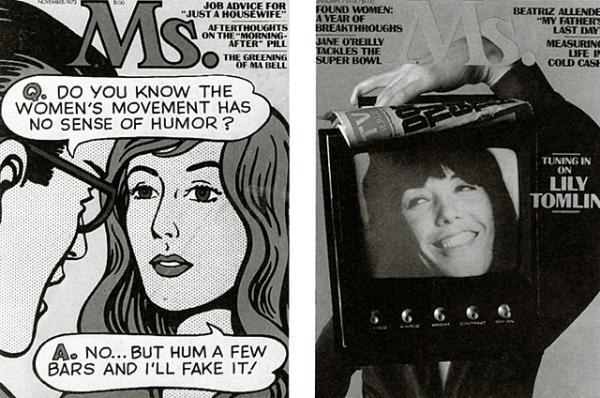
Goldsholl Design Group, Symbols, c. 1975. Thomas H. E. Miller Design Papers, Special Collections and Archives, University of Illinois at Chicago.
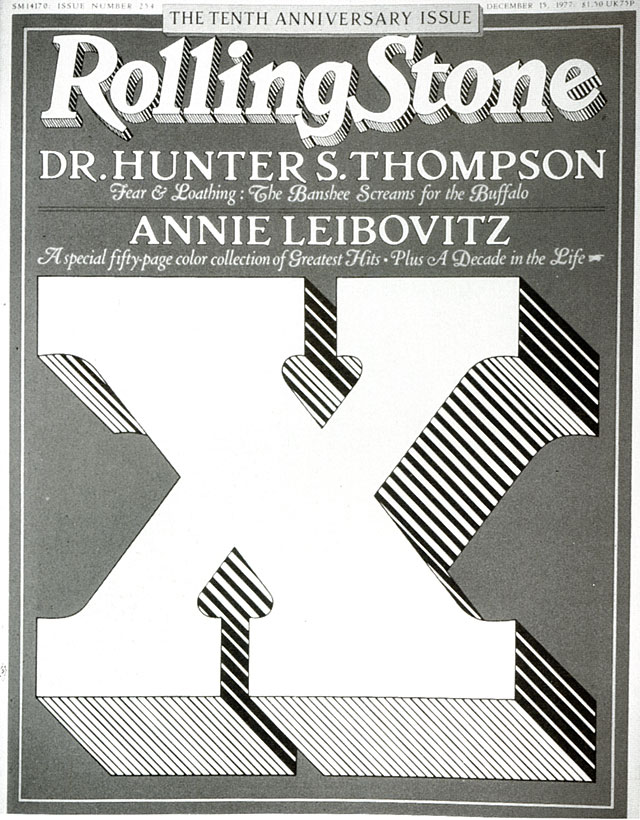
Rolling Stone, December 15, 1977. Art director: Bea Feitler. Copyright © Strait Arrow Publishers, 1977.
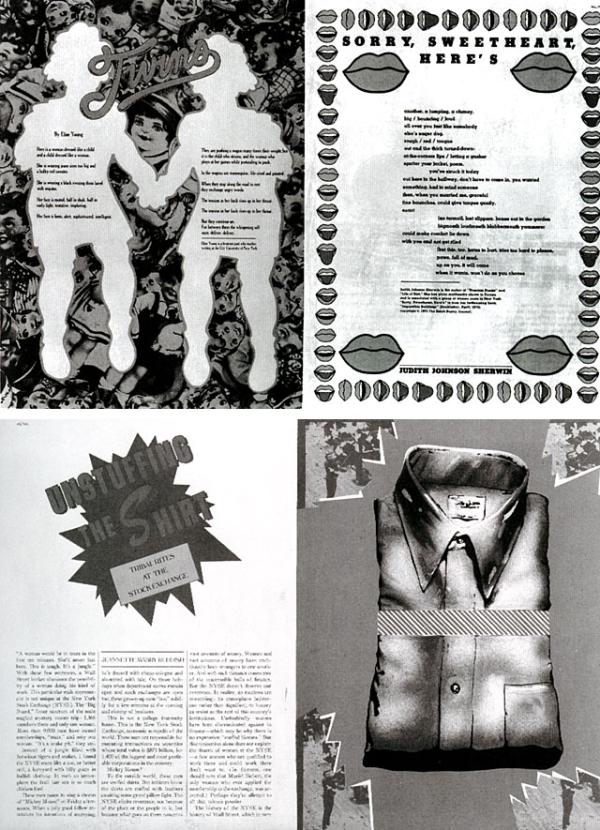
(top) Ms. Magazine, April 1973, pages 78-79. Art Director: Bea Feitler. Copyright © 1973. Courtesy of Ms. Magazine. (bottom) Ms. Magazine, June 1973, pages 46-47. Art Director: Bea Feitler. Copyright © 1973. Courtesy of Ms. Magazine.
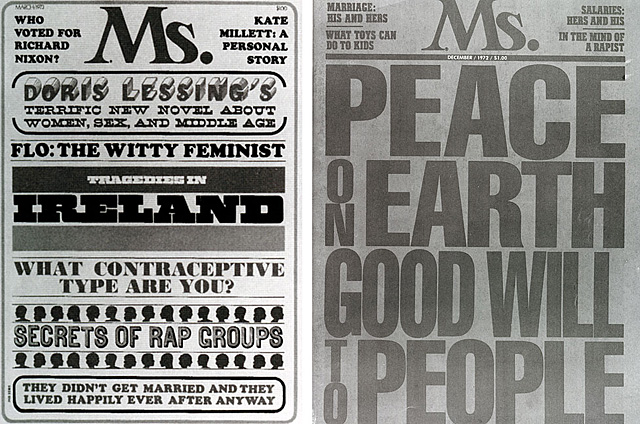
(right) Ms. Magazine, March 1973. Art director: Bea Feitler; Designer: Carl Barile. Copyright © 1973. Cortesy of Ms. Magazine. (left) Ms. Magazine, December 1972. Art Direction: Bea Feitler. Copyright © 1972. Courtesy of Ms. Magazine.
Feitler worked well with photographers, who trusted her judgment and ability to select and design effectively with their images. In addition to close collaboration with photographers having long-standing relationships with Bazaar, such as Avedon and Hiro, Feitler and Ansel brought Bill Silano, Duane Michals, Bill King, and Bob Richardson to the pages of Bazaar. While working on a shoe portfolio with Sinlano, Feitler took him to see the French film A Man and A Woman six times. The lyrical romanticism and elegant cinematography from this landmark movie found its graphic equal in the pages of Bazaar.
Today a two-year tenure by an art director at a major consumer magazine is considered lengthy: the Feitler/Ansel ten-year occupancy of the office made famous by Brodovitch seems remarkable in retrospect. In the early 1970s, a new editor arrived and seemed somewhat unnerved upon inheriting two dynamic young art directors who carried considerable clout. It became apparent that the situation was not feasible. Feitler's final issue was May 1972. She left to join Gloria Steinem in launching the new Ms. Magazine. Ansel art directed Bazaar solo for five months, then departed after the October 1972 issue.
“In one sense, Feitler was always the original feminist,” recalls her longtime associate Carl Barile, who worked with her at Bazaar, Ms., Rolling Stone and on the premiere issue of Vanity Fair, “but her decision to go to Ms. was made because she saw it as an opportunity to be creative and do innovative work.” Her feminism was of the “treat everyone equally” school rather than the militant. And innovate, she did, with editorial designs as startling for the time as the articles appearing in Ms. Feitler used Day-Glo inks, established unique signature formats for various sections of Ms. and mixed photography with illustration. Her typography would be expressionistic and uninhibited. She was willing to cross the line separating the tried and true from the risky and unproved. Many art directors are unwilling to cross this line until fad and fashion certify its acceptability, but Bea Feitler would reach across and return with a novelty face, a decorated letter or a hopelessly eccentric form which happened to be just right for the message at hand. Conventional wisdom decrees that all-type magazine covers are newsstand disaster, but Feitler rattled marketing and outraged some with revisionist scripture on the all-type Ms. cover declaring “Peace on earth, good will to people” in pink and green Day-Glo. It sold out on the newsstands in December 1972. Ms. followed up with a neon-sign version in December 1973.
Her South American heritage influenced her design sensibility about color. She told assistant, “Trust me, listen to me, I know,” while replacing their color selections with vibrant contrasting hues.
At Ms. Feitler made an indelible mark upon the face of American graphic design. Her deep interest in all of the arts was catalytic in expanding the magazine's scope to include cultural coverage. Perhaps she sensed that she was making history by graphically defining a movement and a cultural revolution. But she did not see Ms. and her graphics as the parochial product of strident feminism, she saw them as an all-people movement. Not disenfranchising males who traditionally dominated the culture, but enfranchising those who had been left out. Not only did she commission art and photography from image makers of reputation and renown, she also commissioned art from fine artists, housewives from Brooklyn who made art or crafts and took the subway over to show her their work, and yes from men. She made time for those who showed her their work, and pondered whether their unique and even modest gifts might somehow make a point or provide a counterpoint.
Feitler's assistants were inspired but never governed by her approach to design. She was generous in allowing them to design their assignments and develop their own approaches. She had good judgment and intuition about people. Once a photographer or assistant gained her trust, she would let them fly, helping them to recognize their great potential. Many young designers who worked with her went on to become prominent art directors in their own right, including: Carl Barile and Avenue; Charles Churchward at Vanity Fair; Paula Grief at Mademoiselle; and Barbara Richner at Ms. Her charming personality touched everyone who knew her, but she could also be very demanding. Her standards of design excellence were not negotiable.
Even while art directing major magazines, Feitler had book jacket, album cover and book design projects under way. In 1974 Feitler left Ms. and worked on a variety of projects; Alvin Ailey's City Center dance posters and even costumes; record jackets including Black and Blue for the Rolling Stones; books; magazine designs and redesigns; and ad campaigns for Christian Dior, Diane von Furstenberg, Bill Haire, and Calvin Klein. Her book designs are superb examples of the genre, including The Beatles, Cole, Diaghilev and the Ballets Russe, Lartigue's Diary of a Century, Vogue Book of Fashion Photography 1919-1979 and Helmut Newton's White Women. In this area of design notorious for its flat-as-a-pancake fees, Bea Feitler asked for and received cover credit with the author and/or photographer and negotiated a royalty from the books she designed. The book designer, she reasoned, gives life and joy and form as surely as the author or picture-maker does and should share in the rewards if the book attracted readers. She believed, “Modern books should be 50-50 in terms of visuals and words. People have to be hit over the head and drawn into the book. There is so much visual material in today's world that people can't judge what is good and what is bad. It's up to the graphic designer to set standards.
From 1974 until 1980, Feitler taught advanced students the School of Visual Arts where program head Richard Wilde remembers her as ”one of the very best“ teachers. Students fought to get into her class and she rarely denied entry, once commenting in an interview, ”What really turns me on is the 55 students in my Editorial Design course at the School of Visual Arts.“ After declining to teach one semester due to an overwhelming workload, she called Wilde and asked if she could be assigned a class for the next term. He asked if her workload had lightened. She replied that on the contrary, it had increased, but she needed the inspiration and contact with students which only teaching could provide. As an instructor she was uninhibited, and nothing rattled her. Her interest was in encouraging each student's personal direction. As one example, Wilde recalls that student Keith Haring's graffiti-inspired work had detractors, but Feitler was enthusiastic about its vigor and potential. She encouraged him to further develop his direction. She was a wonderful role model for female students studying design.
A six-year association with Rolling Stone began in 1975. Feitler redesigned its format twice: in 1977 for its tenth-anniversary issue featuring the stunning photographs of Annie Leibovitz; and again in 1981 when it shifted from a tabloid to the current magazine format. In 1978, Feitler signed on as a consulting art director for Condé Nast Publications and created the graphic image for a new publication, Self. Editor-in-Chief Phyllis Wilson credited much of Self's distinctiveness to Feitler's experimental design approach and perceptive ability to work with photographs, ”seeing them and cropping them and moving them [until] you got something that would suddenly turn exciting.“
Her final project was the premiere issue of the revived Vanity Fair, which appeared after her death in 1982. She underwent surgery twice for a rare form of cancer. Her spirits were undaunted and many close associates at Condé Nast did not know she had been undergoing chemotherapy for several months. They thought her stylish turbans were a fashion statement. An associate took the mechanicals for the premiere issue of Vanity Fair to her apartment for her approval. After completing the issue, she went home to Brazil and did not live to see it published.
Bea Feitler only lived 44 years, but filled them with energy, enthusiasm and a passion for life and design. Hundreds of people attended her memorial service, and as a living tribute her friends and family established the Bea Feitler Foundation, which funds a full one-year scholarship for a junior graphic-design student at the School of Visual Arts. She believed a graphic designer's work matters because the culture is expanded and enriched by those who shape and form information. She is missed for the vision, passion, and vitality she brought to each day's life and work and remembered for her profound contribution.
Copyright 1990 by The American Institute of Graphic Arts.
Keep in Touch with AIGA
Sign up for email communications to be the first for updates on webinars, events, programs, and announcements.